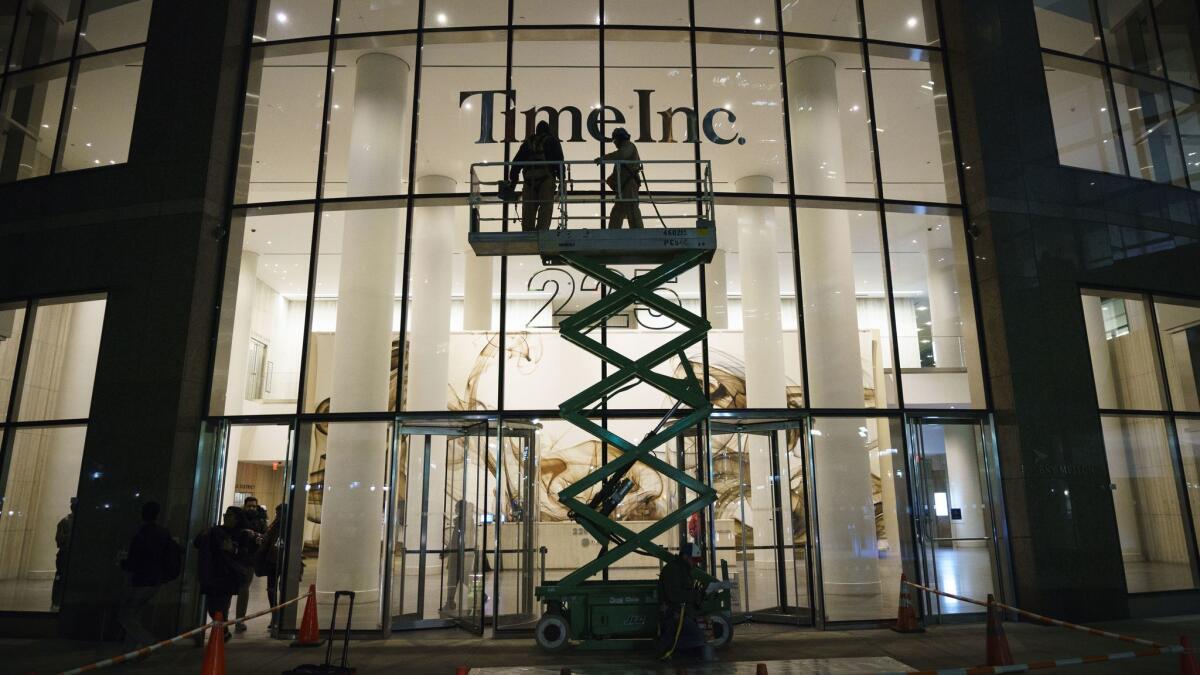Op-Ed: What Time Inc. was best at in the glory days: overspending horrendously

I started as a writer at Time Magazine on a Monday in 1998. I turned up that morning to find the 23rd floor of the Time-Life building, the editorial offices, deserted. Nobody at Time went in to work on Mondays. The magazine operated on a Tuesday through Friday schedule. That was the first of many quirks I would enjoy at what was still an immensely profitable enterprise. Time, that year following the death of Princess Diana and preceding the death of John F. Kennedy Jr., was a cash cow. Those celebrity death covers sold so well that Time published second-week covers on the same celebrity deaths.
Now Time Inc., Time’s parent company, has joined the ranks of the celebrity dead: It was acquired recently by Meredith Inc., a Des Moines-based publisher, and officially ceased to exist on Feb. 1. Time Inc. signage no longer adorns corporate headquarters in Manhattan, a symbolic coup de grace. But the company’s decline was long in the making, steady and unremitting. And in retrospect, the cracks in the foundation were present even during the boom years.
At Time Inc.’s flagship magazine, there was no orientation, no instruction, no one to welcome me to the empty offices on my first day. I was one of a dozen or so younger writers hired by Managing Editor Walter Isaacson to infuse the magazine with a youthful sensibility. I was assigned to the business section, where instead of infusing, I started mimicking, seeking to make my stories as indistinguishable as possible from those that came before and after, whether in that particular issue or chronologically since the founding of the magazine in 1922. I watched some of my peers fail, and was jealous when some — hello, Joel Stein! — seemed to become favorites of Isaacson and his successor, Jim Kelly.
Isaacson would later insist that they never instructed us by design, so they could ascertain who was a self-starter. We competed to be the best at mimicking the magazine, which meant we were essentially mimicking each other, as gradually, once the less successful impersonators were weeded out, we became the writers relied upon to fill the book each week.
The late 1990s turned out to be the last lush years at Time Magazine, when almost all of the Time Inc. titles — Sports Illustrated, Fortune, Entertainment Weekly, People — made money, lots and lots of money. They gave me an organization chart, that first week, that included everything Time-Warner owned. There were TV networks, news channels, a movie studio, sports franchises, record labels, book publishers, comic book publishers, even a wrestling league.
The disastrous merger with AOL was still a couple of years away. The legendary drink carts were gone, but we took a livery car home every night if we wanted and we had unlimited expense accounts. And I mean unlimited: I remember turning in monthly T&E’s exceeding $25,000, and one editor supposedly ran up $880,000 in expenses in a single year. The process of submitting expenses required calling a subcontracted company and then manually inputting each item using the phone keypad. We all complained about the laborious process but nobody ever complained about the ridiculous amounts we were charging to the company.
We had corporate matching for our 401ks, profit sharing, stock options and stock awards. It felt like we were getting paid six different ways.
At the end of the year, Time managing editor Jim Kelly would give me a $100,000 bonus. And it all felt normal.
In my first year I sensed I was going to make it at Time; by the second, year, Time Inc. Editor in Chief Norman Pearlstine had somehow deduced from my mimicry that I was management material, and began offering me all sorts of jobs. To Time Inc.’s credit, the higher-ups were always looking to promote writers and editors of color.
I was eventually made the editor of Time Asia, based in Hong Kong, with a circulation of 450,000, a staff of a few hundred, and bureaus all over Asia. I had a housing allowance — the company rented me a beautiful flat on Barker Road, near the Peak — a company car, club memberships, a generous cost of living allowance and tax equalization. I flew business class.
I never knew our budget. I just hired staffers and spent freely on freelancers, assuming that, at some point, if I was overspending, someone would come to my office and alert me. Nobody ever came. At the end of the year, Time managing editor Jim Kelly would give me a $100,000 bonus. And it all felt normal.
It turned out we were overspending. Horrendously. That’s what we were best at.
We wrote some good pieces and I certainly learned a great deal about writing, but Time had already lost whatever scrappiness or journalistic hustle it had once had, if, indeed, it had ever had any.
The magazine that Henry Luce and Briton Hadden founded had always been a clip job, a digest of the week’s news. It didn’t break stories, it broke them down so that Middle America could easily digest them. The internet obviated that function and the AOL deal, finalized in 2000, was both visionary and tragic in that CEO Gerald Levin saw the future coming, but totally misread how to play it.
We became a magazine company attached to a dial-up company as the whole world was getting wired for high-speed internet. We didn’t have the reflexes to survive in this new newsgathering ecosystem because what we excelled at, besides overspending, was mimicking news gathering.
I would return from Hong Kong to edit and write at Sports Illustrated, helping to launch Sports Illustrated China before the Beijing Olympics. By then, ESPN had already changed the sports landscape and no one needed a magazine to keep them up to date with scores or results. Sports Illustrated had and still has great sports writers. And there is an audience that wants to read literary sports writing. But that audience is not large enough to sustain the Time Inc. infrastructure. The expense accounts. The black cars. The generous bonuses. You need circulations in the mid-seven figures and dozens of pages of advertising to fuel all that.
When circulations contracted, advertisers moved on to the web. We all know the story.
But here’s some perspective as to how flush it all was. Scripted television is a booming industry and I’m in my second season as a writer on a popular show. Without adjusting for inflation, I made more money as a writer at Time Magazine in 1999.
You can’t blame us for enjoying it while it lasted, even if our enjoyment is why it couldn’t last.
Karl Taro Greenfeld is a writer on Ray Donovan. His latest novel, “True,” will be published in June.
Follow the Opinion section on Twitter @latimesopinion or Facebook
More to Read
A cure for the common opinion
Get thought-provoking perspectives with our weekly newsletter.
You may occasionally receive promotional content from the Los Angeles Times.










